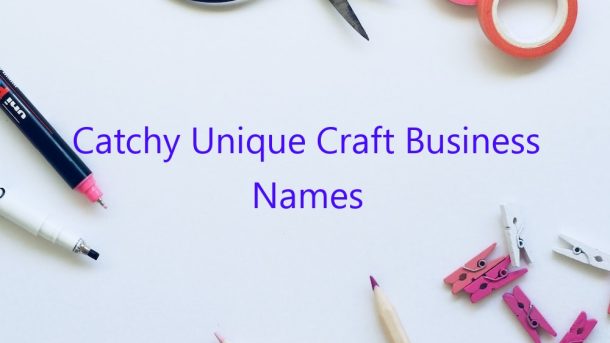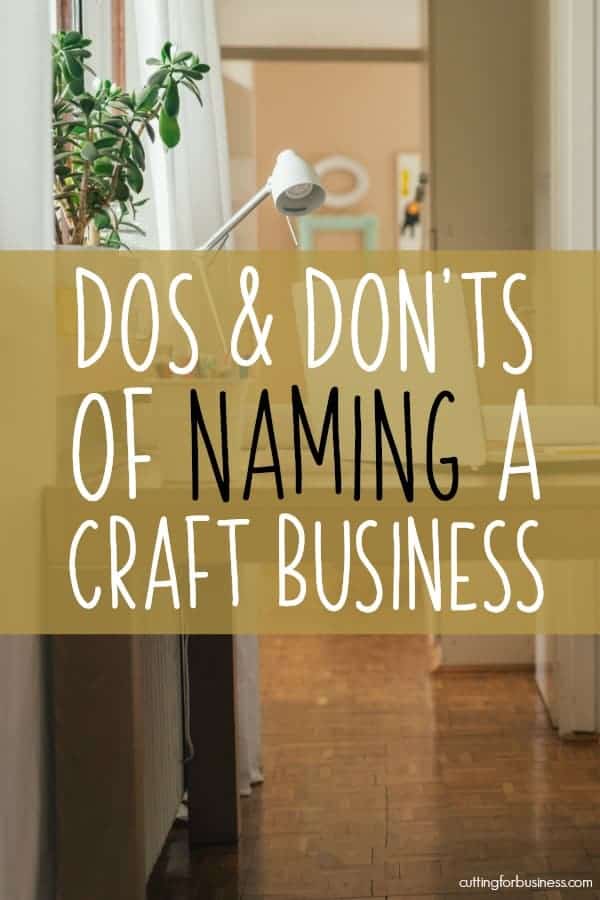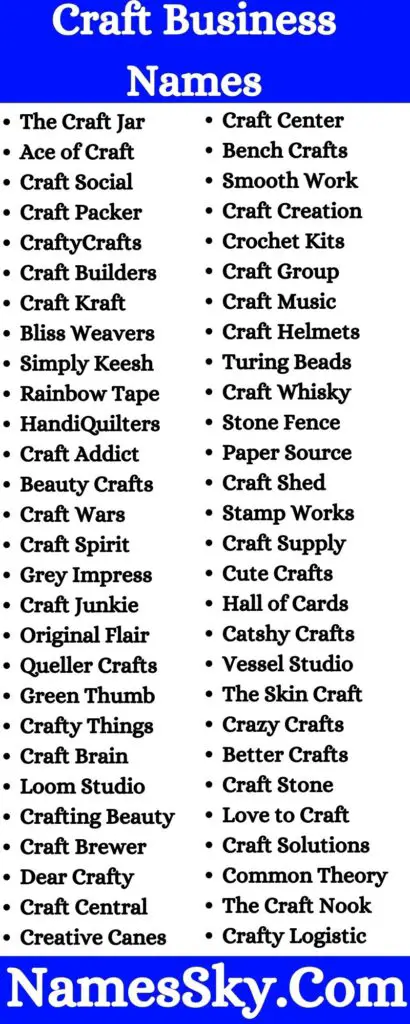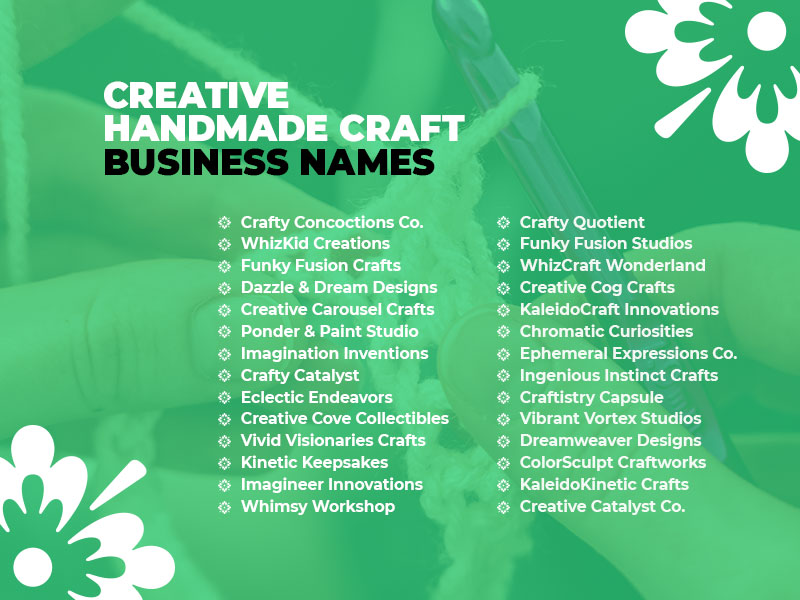Why a Catchy Business Name Matters for Craft Entrepreneurs
A unique and memorable business name is crucial for craft entrepreneurs, as it plays a significant role in branding, marketing, and customer recognition. A well-crafted business name can help establish a strong brand identity, differentiate a business from competitors, and create a lasting impression on customers. In the world of crafts, where creativity and individuality are highly valued, a catchy business name can be a key factor in attracting and retaining customers.
A business name that is both unique and memorable can also improve a company’s online visibility, making it easier for customers to find and remember the business. This, in turn, can lead to increased website traffic, social media engagement, and ultimately, sales. Furthermore, a catchy business name can be a valuable asset for craft entrepreneurs, as it can be used to create a consistent brand image across various marketing channels, including business cards, packaging, and advertising materials.
In addition, a unique business name can help craft entrepreneurs establish a strong emotional connection with their target audience. A name that reflects the values, personality, and style of the business can create a sense of authenticity and trust, making customers more likely to engage with the brand. For example, a craft business that specializes in handmade jewelry might choose a name that evokes a sense of luxury, elegance, and sophistication, such as “Adorned with Love” or “Treasured Trinkets.”
Overall, a catchy and unique business name is essential for craft entrepreneurs who want to establish a strong brand identity, attract and retain customers, and stand out in a competitive market. By choosing a name that is both memorable and meaningful, craft entrepreneurs can create a lasting impression on their target audience and build a successful business that reflects their values and creativity.
How to Brainstorm a Unique Craft Business Name
Brainstorming a unique craft business name can be a fun and creative process. To get started, try using word associations to generate ideas. Write down a list of words related to your craft, such as “sewing,” “fabric,” “thread,” and “needle.” Then, use these words to create new combinations, such as “Sew Happy” or “Threaded Treasures.”
Another technique is to combine words to create a unique name. For example, “Crafty Creations” or “Handmade Haven.” You can also try using alliteration, such as “Sew Sweet Studios” or “Fiber Fusion.” Additionally, consider drawing inspiration from nature, art, and culture. For example, “River Rock Crafts” or “Mosaic Magic.”
Using a mind map can also be a helpful tool in brainstorming a unique craft business name. Start with a central idea, such as your craft, and then branch out to related ideas and words. This can help you visualize your ideas and make connections between different concepts.
It’s also important to consider the tone and personality you want your business name to convey. Do you want to be seen as fun and playful, or professional and sophisticated? Choose a name that reflects your brand’s values and personality.
Finally, don’t be afraid to think outside the box and come up with something completely unique. A catchy and unique craft business name can help you stand out in a crowded market and attract attention from potential customers. Some examples of unique craft business names include “Whimsy & Co.,” “The Crafty Crow,” and “Maker’s Muse.”
By using these techniques and tips, you can come up with a unique and catchy craft business name that reflects your brand’s personality and values. Remember to have fun and be creative during the brainstorming process, and don’t be afraid to try out new and different ideas.
Exploring Different Naming Styles for Craft Businesses
When it comes to choosing a name for a craft business, there are several naming styles to consider. Each style has its own unique characteristics and can help to create a catchy and memorable name. In this section, we’ll explore some of the most popular naming styles for craft businesses, including alliteration, assonance, and consonance.
Alliteration is a popular naming style that involves repeating the same sound at the beginning of each word. For example, “Sew Sweet Studios” or “Fiber Fusion Factory.” Alliteration can create a fun and playful name that is easy to remember. Many successful craft businesses use alliteration in their names, such as “The Knitting Nook” or “The Quilting Queen.”
Assonance is another naming style that involves repeating vowel sounds within words. For example, “Crafty Creations” or “Handmade Haven.” Assonance can create a smooth and melodic name that is pleasing to the ear. Some successful craft businesses that use assonance in their names include “The Sewing Sanctuary” or “The Beading Boutique.”
Consonance is a naming style that involves repeating consonant sounds within words. For example, “The Crafty Collective” or “The Maker’s Market.” Consonance can create a strong and distinctive name that is easy to remember. Some successful craft businesses that use consonance in their names include “The Woodworking Workshop” or “The Metalworking Studio.”
In addition to these naming styles, many craft businesses also use wordplay, puns, and clever turns of phrase to create a catchy and memorable name. For example, “The Yarn Yard” or “The Fiber Factor.” These types of names can be especially effective for craft businesses that want to stand out and create a unique brand identity.
Ultimately, the key to choosing a great name for a craft business is to select a name that reflects the business’s values, personality, and style. By considering different naming styles and techniques, craft entrepreneurs can create a catchy and unique name that helps to establish their brand and attract customers.
Using Your Name, Initials, or Location in Your Craft Business Name
When it comes to choosing a name for a craft business, many entrepreneurs consider using their own name, initials, or location as part of the business name. This can be a great way to add a personal touch and create a sense of authenticity, but it’s essential to weigh the pros and cons before making a decision.
Using your name or initials in your craft business name can be beneficial in several ways. For one, it can help to establish a personal connection with customers and create a sense of trust. Additionally, it can be easier to build a brand identity around a name that is already familiar to you and your customers. For example, “Smith’s Sewing Studio” or “Jen’s Jewelry Designs” can be effective names that incorporate the owner’s name.
However, there are also potential drawbacks to consider. Using your name or initials in your business name can make it more difficult to sell the business in the future, as the name is closely tied to the owner’s identity. Additionally, if you decide to change your business name later on, it can be challenging to rebrand and establish a new identity.
Using your location in your craft business name can also be a good idea, especially if you’re targeting a local customer base. For example, “New York City Knits” or “California Craft Co.” can be effective names that evoke a sense of place and local pride. However, it’s essential to consider whether your business will be limited to a specific geographic area or if you plan to expand to other regions.
Ultimately, whether or not to use your name, initials, or location in your craft business name depends on your specific business goals and target market. It’s crucial to consider the potential benefits and drawbacks and choose a name that reflects your brand’s values and personality.
Some successful craft businesses that use their name, initials, or location in their business name include “Emily Ley Designs,” “The Brooklyn Craft Company,” and “San Francisco Sewing Studio.” These businesses have effectively incorporated their name or location into their brand identity and created a unique and memorable name that resonates with their target market.
Creating a Memorable and Easy-to-Spell Craft Business Name
A memorable and easy-to-spell craft business name is crucial for building a strong brand identity and attracting customers. A name that is easy to remember and spell can help to establish a positive first impression and make it easier for customers to find and recommend your business.
One of the most important tips for creating a memorable and easy-to-spell craft business name is to use simple language. Avoid using complex words or phrases that may be difficult for customers to understand or remember. Instead, opt for a name that is clear, concise, and easy to spell.
Another tip is to avoid using numbers and symbols in your craft business name. While these may seem like a good idea, they can be difficult to remember and spell, and may not be easily recognizable by search engines and other online platforms.
Testing your craft business name with friends and family is also a great way to ensure that it is memorable and easy to spell. Ask them to repeat the name back to you and see if they can spell it correctly. This can help to identify any potential issues with the name and make adjustments before finalizing your business name.
In addition to using simple language and avoiding numbers and symbols, it’s also important to consider the length and rhythm of your craft business name. A shorter name with a clear and consistent rhythm can be more memorable and easier to spell than a longer name with a complex rhythm.
Some examples of memorable and easy-to-spell craft business names include “Crafty Creations,” “Handmade Haven,” and “The Sewing Studio.” These names are clear, concise, and easy to remember, making them more likely to attract and retain customers.
By following these tips and creating a memorable and easy-to-spell craft business name, you can establish a strong brand identity and attract customers who are looking for unique and high-quality craft products.
Checking the Availability of Your Desired Craft Business Name
Once you have brainstormed a list of potential names for your craft business, it’s essential to check the availability of each name to ensure that it’s not already in use by another business or individual. This is a crucial step in the naming process, as it can help you avoid potential trademark issues and ensure that your business name is unique and memorable.
One of the first steps in checking the availability of your desired craft business name is to search for domain names. You can use online tools such as GoDaddy or Namecheap to search for available domain names that match your business name. If the domain name is available, you can register it to secure your online presence.
In addition to searching for domain names, you should also check for available social media handles. This includes searching for usernames on platforms such as Facebook, Instagram, Twitter, and Pinterest. If the social media handle is available, you can create a profile to establish your business’s online presence.
Another important step in checking the availability of your desired craft business name is to search for trademark registrations. You can use the United States Patent and Trademark Office (USPTO) database to search for existing trademarks that may be similar to your business name. If a similar trademark is already registered, you may need to choose a different name to avoid potential trademark issues.
It’s also a good idea to check for business name availability in your state or country. You can use online tools such as the Secretary of State website or the Small Business Administration website to search for available business names. If the business name is available, you can register it with the state or country to secure your business’s identity.
By checking the availability of your desired craft business name, you can ensure that your business name is unique, memorable, and available for use. This is an essential step in establishing a strong brand identity and avoiding potential trademark issues.
Some examples of craft businesses that have successfully checked the availability of their desired business name include “The Crafty Crow” and “Handmade Haven.” These businesses have secured their online presence by registering their domain names and social media handles, and have also checked for trademark registrations and business name availability in their state or country.
Examples of Catchy and Unique Craft Business Names
When it comes to choosing a catchy and unique craft business name, there are many different approaches you can take. Here are a few examples of successful craft businesses with names that stand out:
One example is “Purlfectly Handmade,” a knitting and crochet business with a name that plays on the word “perfect” and incorporates a knitting term. This name is catchy and memorable, and immediately conveys the business’s focus on handmade products.
Another example is “The Crafty Crow,” a business that sells handmade jewelry and home decor items. This name is unique and memorable, and the use of alliteration makes it fun and engaging.
“Handmade Haven” is another example of a catchy and unique craft business name. This name conveys a sense of warmth and welcoming, and immediately suggests that the business is focused on handmade products.
Some craft businesses also use wordplay or puns in their names, such as “Knit Wits” or “Sew Happy.” These names are catchy and memorable, and can help to establish a business’s brand identity.
Other examples of catchy and unique craft business names include “The Fiber Factor,” “The Sewing Studio,” and “The Crafty Collective.” These names are all memorable and easy to spell, and immediately convey the business’s focus on craft and handmade products.
When choosing a name for your craft business, it’s essential to consider what makes your business unique and what will resonate with your target audience. By brainstorming a list of potential names and testing them with friends and family, you can find a name that is both catchy and memorable.
Remember, your business name is often the first impression that potential customers will have of your business, so it’s essential to choose a name that accurately reflects your brand and values. By choosing a catchy and unique craft business name, you can establish a strong brand identity and attract customers who are looking for high-quality, handmade products.
Final Tips for Choosing a Craft Business Name That Stands Out
Choosing a craft business name that stands out can be a challenging but rewarding process. Here are some final tips and advice to help you choose a name that is both catchy and unique:
Be patient and persistent. Choosing a business name is a process that takes time and effort. Don’t rush into a decision, and be willing to try out different options until you find the one that works best for your business.
Be creative and think outside the box. A unique and memorable business name is often one that is creative and unexpected. Don’t be afraid to try out new and different ideas, and don’t be limited by traditional naming conventions.
Consider your target audience. Your business name should reflect the values and personality of your target audience. Think about what kind of name will resonate with your customers and help to establish a connection with them.
Keep it simple and easy to spell. A simple and easy-to-spell business name is essential for building a strong brand identity. Avoid using numbers and symbols, and opt for a name that is easy to remember and pronounce.
Test your name with friends and family. Once you have a list of potential names, test them out with friends and family to get their feedback and opinions. This can help you to identify any potential issues with the name and make adjustments before finalizing your decision.
Remember, your business name is a reflection of your brand and values. Choose a name that accurately reflects your business and resonates with your target audience. With patience, persistence, and creativity, you can choose a craft business name that stands out and helps to establish a strong brand identity.
By following these tips and advice, you can choose a craft business name that is both catchy and unique. Remember to be patient, persistent, and creative in the naming process, and don’t be afraid to try out new and different ideas. With the right name, you can establish a strong brand identity and attract customers who are looking for high-quality, handmade products.







